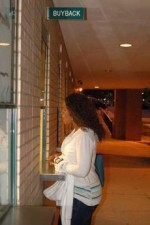Buyback bargaining

With buyback season in full swing, students are hoping to get as much cash as they can.
However, selling textbooks back to convenient bookstores may not be the most profitable method.
Online sellers such as Amazon.com and Half.com offer additional possibilities for students seeking to maximize their returns. Still, for those looking to put money in their pockets immediately, buyback continues to be the most attractive option.
At the USF Bookstore, students receive about 50 percent of the book’s original purchase price if the Bookstore knows the book can be sold the following semester, which depends entirely on the professor’s decision to continue its use.
“The most critical piece (of information) about buyback is knowing what professors are using for the upcoming term,” said Jade Roth, vice president for books at Barnes and Noble, the company which operates the USF Bookstore. “A successful buyback is based on how successful a bookstore manager is in getting course information from the faculty.”
Bookstore managers, however, often don’t know what books professors plan to use until the end of the semester.
That’s why now, when most of the book decisions have been made, is the ideal time for students to get the most money back, said Jeff Mack, assistant vice president of USF Campus Business Services.
“Students who bring their books back right around exam week typically receive the highest amount at buyback,” Mack said.
Books bought back by the Bookstore are resold at the used price, which is 75 percent of the book’s original purchase price. So a book purchased new for $100, then sold the following semester, could be bought back by the bookstore for $50 and resold as used for $75.
How the Bookstore deals with books that won’t be resold next semester depends on the level of demand and supply for the book nationally, Roth said. The Bookstore can often sell scarce books or books widely used at other universities to book wholesalers. According to Roth, the wholesalers dictate what books are bought by the Bookstore and the offered price for buyback. The higher the demand and lower the supply of the book, the more likely the wholesaler will want it and the more students can get for it.
Even students who bought their books online or from other booksellers can sell them back to the USF Bookstore, provided they have resale value for the Bookstore or their wholesale partners, Roth said.
“It doesn’t matter where you bought it, we’ll buy it back, so long as it has value,” she said. “Buyback really is our most effective source for used books.”
In addition to the Bookstore, savvy students can use online booksellers to maximize their returns. Amazon.com and Half.com, among others, act as virtual marketplaces, allowing students to sell their books to buyers across the country. Books are listed according to their quality and asking price.
Depending on the book, its popularity, its availability, its quality and its time in print, students may be able to get more for their books online.
The book, Foundations of Electrical Engineering, used as a text in electrical engineering courses at USF, can be sold back to the bookstore for $59.50. On Amazon.com, selling prices for used copies of this book range from $30 to $100. On Half.com the range of prices is about the same. For Essentials of the Living World, a text used in introduction biology courses at USF, the books store offers $48.30. On Amazon.com and Half.com selling prices start at $25 and end at $60.
So students could conceivably get more by selling books online.However, commissions and other fees charged by online sellers can cut into any potential profit margin, and that’s if students can sell the book online at all.
Amazon charges a 99 cent fee plus a 15 percent commission on the book’s selling price. Half.com charges a 5.25 percent commission for the first $25 of the selling price and 3 percent for any amount exceeding $25.
If the book sells, students must pack it and ship it, which is less convenient than selling it directly to the bookstore.






